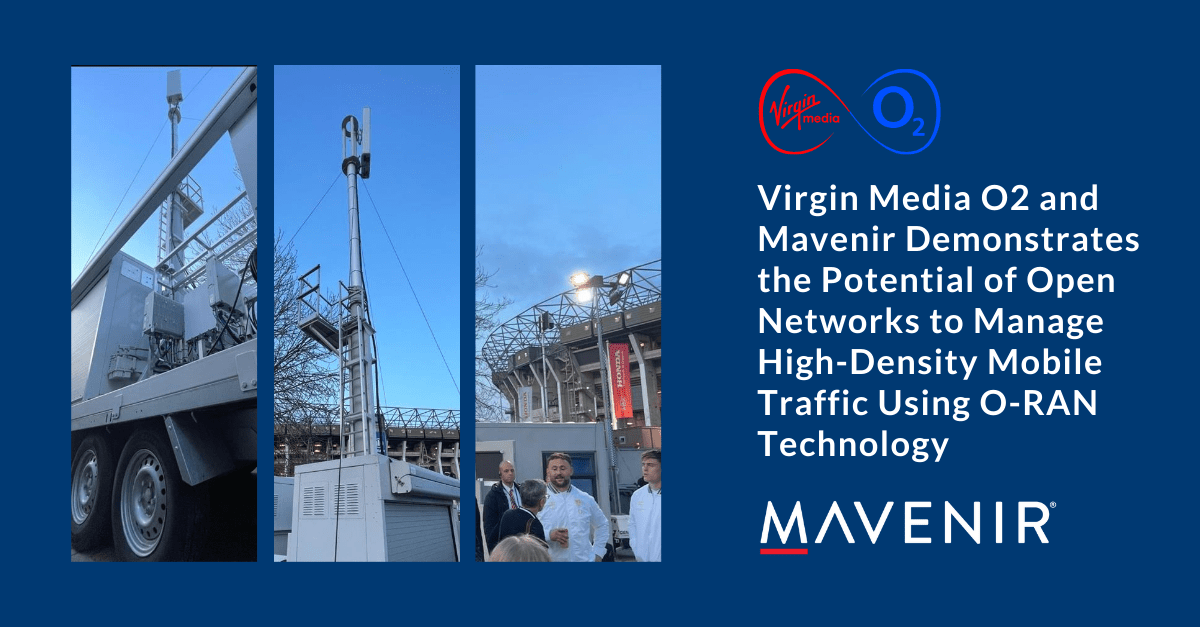Mavenir and Northeastern University Announce the Availability of Open-Source Open RAN Simulation Platform
Enables detailed, end-to-end simulation of 5G Radio Access Network (RAN) optimized by O-RAN Near Real-Time RAN Intelligent Controller (Near-RT RIC) over E2.
Richardson, TX and Boston, MA – October 11th, 2022: Researchers at the Institute for the Wireless Internet of Things (WIoT) at Northeastern University and Mavenir, Mobile Network Software Provider, are pleased to announce the public availability of ns-O-RAN (Open Radio Access Network Simulator), the first open-source platform for end-to-end simulation of 5G wireless networks driven and optimized by Open Radio Access Network (Open RAN) components.
The ns-O-RAN simulator integrates ns-3 with O-RAN-compliant features, including the E2 application protocol and service models, to interface with an O-RAN standards-compliant Near-RT RIC. This effort results from a collaboration between the Institute for the Wireless Internet of Things (WIoT) of Northeastern University and Mavenir, which is a member of the WIoT Industry Consortium and of the Open6G initiative led by WIoT. The ns-O-RAN simulator builds on the popular open-source network simulator ns-3, a functional end-to-end network simulator that simulates all the layers of the RAN protocol stack along with core network functions and mobile traffic applications, and its 5G module from the University of Padova and NYU, that facilitates the LTE-5G NR dual connectivity RAN protocol stack on ns-3.
ns-O-RAN has been designed and implemented to enable the integration of O-RAN software such as Mavenir’s Near-RT RIC with large-scale 5G simulations based on 3GPP channel models and a detailed modeling of the full 3GPP RAN protocol stack. This allows data collection of RAN Key Performance Metrics (KPMs) at scale, in different simulated scenarios, and with different applications (e.g., multimedia streaming, web browsing, wireless virtual reality, etc). ns-O-RAN supports an O-RAN-compliant E2 interface and implements two E2 service models (E2SM), E2SM-Key Performance Metrics (KPM) monitoring and E2SM-RAN Control (RC), that enable a closed-loop control (for example, of traffic steering and mobility).
“The goal of ns-O-RAN is to kickstart research on control of 5G RAN systems using xApps and the Open RAN interfaces” says Prof. Tommaso Melodia, Director of Northeastern University’s Institute for the Wireless Internet of Things, and Director of Research for the PAWR Project Office. “This includes research and development of methods and techniques based on big data, machine learning, and artificial intelligence (AI).”
“WIoT and Mavenir have used ns-O-RAN to prototype xApps to perform intelligent closed-loop control of handovers. Our optimization solutions are leveraging fine-grained UE-specific performance metrics based on E2SM-KPM, and UE-specific closed-loop control actions based on E2SM-RC, standardized in O-RAN and subsequently built-in ns-O-RAN, which substantially improves the throughput and spectral efficiency by an average of 30-50%, when compared to traditional heuristics, SON solutions and Non-O-RAN-based RRM solutions.” said Bejoy Pankajakshan, Executive Vice President and Chief Technology & Strategy Officer at Mavenir. “The integration of ns-O-RAN and O-RAN-compliant Near-RT RICs makes it possible to develop xApps once and test them against simulation before transitioning them to testbeds and commercial public or private 5G deployments, thus making ns-O-RAN a key platform for the development and testing of intelligent xApps.”
ns-O-RAN is part of a suite of tools for research on intelligent Open RAN systems developed by WIoT. Notably, ns-O-RAN extends the Open RAN Gym framework to the simulation domain. Open RAN Gym is a publicly available framework that combines large-scale experimental testbeds and software-defined RAN and O-RAN frameworks to enable end-to-end design and testing of data-driven xApps. It has been used to develop and demonstrate xApps for RAN slicing and spectrum management on publicly available experimental testbeds, including Colosseum and the Platforms for Advanced Wireless Research (PAWR) testbeds. Open RAN Gym has also been used to show how intelligent xApps trained on wireless emulation platforms can be deployed on an over-the-air network without the need for re-training. Simulation with ns-O-RAN will provide another component to the Open RAN Gym toolbox, further extending the data collection and xApp testing capabilities that are available to the wireless research community.
About the Institute for the Wireless Internet of Things at Northeastern University:
WIoT is an academic member of the O-RAN Alliance and has been leading research projects with several industrial partners in the area. The research on fully programmable, open, and virtualized wireless networks at WIoT has been supported by the U.S. National Science Foundation and the U.S. Office of Naval Research. PAWR and Colosseum are supported by the National Science Foundation. WIoT research is sponsored by an assemble of Federal research agencies including the National Science Foundation, Air Force Research Laboratory, Department of Homeland Security, IARPA, AFOSR, Department of Defense, DARPA, Army Research Office, NASA, MassTech Collaborative, Department of Transportation.
For more information on the Institute for the Wireless Internet of Things, please visit www.northeastern.edu/wiot



